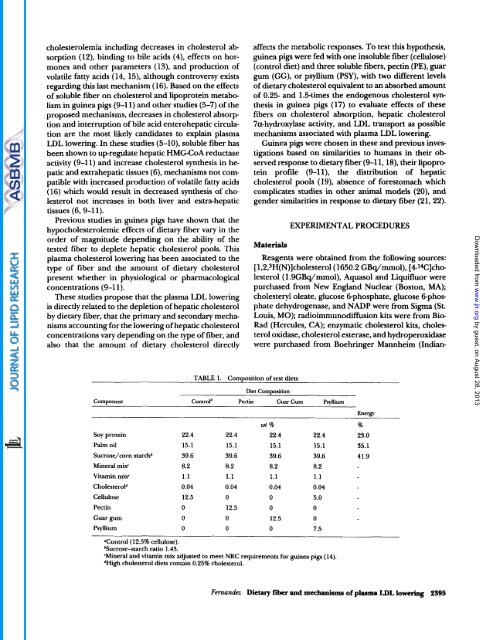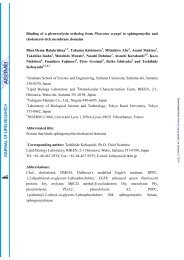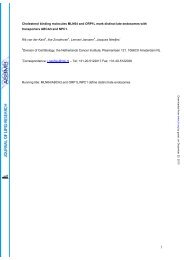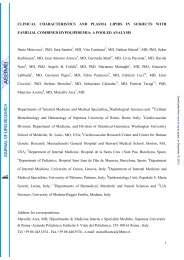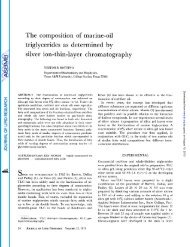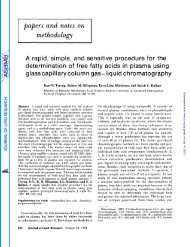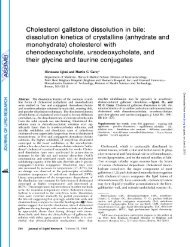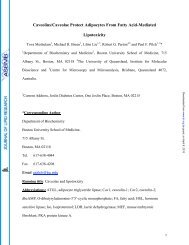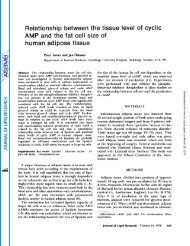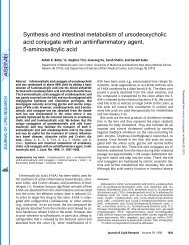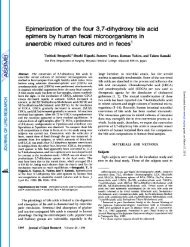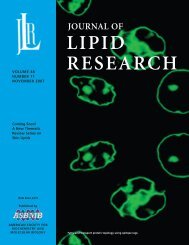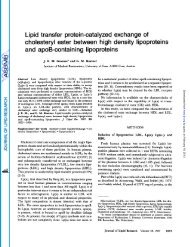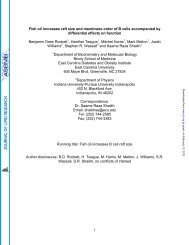a LDL lowering by - The Journal of Lipid Research
a LDL lowering by - The Journal of Lipid Research
a LDL lowering by - The Journal of Lipid Research
Create successful ePaper yourself
Turn your PDF publications into a flip-book with our unique Google optimized e-Paper software.
cholesterolemia including decreases in cholesterol absorption<br />
(12), binding to bile acids (4), effects on hormones<br />
and other parameters (13), and production <strong>of</strong><br />
volatile fatty acids (14, 15), although controversy exists<br />
regarding this last mechanism (16). Based on the effects<br />
<strong>of</strong> soluble fiber on cholesterol and lipoprotein metabolism<br />
in guinea pigs (9-1 1) and other studies (5-7) <strong>of</strong> the<br />
proposed mechanisms, decreases in cholesterol absorption<br />
and interruption <strong>of</strong> bile acid enterohepatic circulation<br />
are the most likely candidates to explain plasma<br />
<strong>LDL</strong> <strong>lowering</strong>. In these studies (5-lo), soluble fiber has<br />
been shown to up-regulate hepatic HMG-CoA reductase<br />
activity (9-1 1) and increase cholesterol synthesis in hepatic<br />
and extrahepatic tissues (6), mechanisms not compatible<br />
with increased production <strong>of</strong> volatile fatty acids<br />
(16) which would result in decreased synthesis <strong>of</strong> cholesterol<br />
not increases in both liver and extra-hepatic<br />
tissues (6,9-11).<br />
Previous studies in guinea pigs have shown that the<br />
hypocholesterolemic effects <strong>of</strong> dietary fiber vary in the<br />
order <strong>of</strong> magnitude depending on the ability <strong>of</strong> the<br />
tested fiber to deplete hepatic cholesterol pools. This<br />
plasma cholesterol <strong>lowering</strong> has been associated to the<br />
type <strong>of</strong> fiber and the amount <strong>of</strong> dietary cholesterol<br />
present whether in physiological or pharmacological<br />
concentrations (9-1 1).<br />
<strong>The</strong>se studies propose that the plasma <strong>LDL</strong> <strong>lowering</strong><br />
is directly related to the depletion <strong>of</strong> hepatic cholesterol<br />
<strong>by</strong> dietary fiber, that the primary and secondary mechanisms<br />
accounting for the <strong>lowering</strong> <strong>of</strong> hepatic cholesterol<br />
concentrations vary depending on the type <strong>of</strong> fiber, and<br />
also that the amount <strong>of</strong> dietary cholesterol directly<br />
affects the metabolic responses. To test this hypothesis,<br />
guinea pigs were fed with one insoluble fiber (cellulose)<br />
(control diet) and three soluble fibers, pectin (PE), guar<br />
gum (GG), or psyllium (PSY), with two different levels<br />
<strong>of</strong> dietary cholesterol equivalent to an absorbed amount<br />
<strong>of</strong> 0.25- and 1.5times the endogenous cholesterol synthesis<br />
in guinea pigs (17) to evaluate effects <strong>of</strong> these<br />
fibers on cholesterol absorption, hepatic cholesterol<br />
7a-hydroxylase activity, and <strong>LDL</strong> transport as possible<br />
mechanisms associated with plasma <strong>LDL</strong> <strong>lowering</strong>.<br />
Guinea pigs were chosen in these and previous investigations<br />
based on similarities to humans in their observed<br />
response to dietary fiber (9-1 1,18), their lipoprotein<br />
pr<strong>of</strong>ile (9-1 l), the distribution <strong>of</strong> hepatic<br />
cholesterol pools (19), absence <strong>of</strong> forestomach which<br />
complicates studies in other animal models (20), and<br />
gender similarities in response to dietary fiber (21,22).<br />
Materials<br />
TABLE 1. Composition <strong>of</strong> test diets<br />
EXPERIMENTAL PROCEDURES<br />
Reagents were obtained from the following sources:<br />
[ 1,2,3H(N)]cholestero1 (1650.2 GBq/mmol), [4W]cholesterol<br />
(1.9GBq/mmol), Aquasol and Liquifluor were<br />
purchased from New England Nuclear (Boston, MA);<br />
cholesteryl oleate, glucose 6-phosphate, glucose 6-phosphate<br />
dehydrogenase, and NADP were from Sigma (St.<br />
Louis, MO); radioimmunodiffusion kits were from Bio-<br />
Rad (Hercules, CA); enzymatic cholesterol kits, cholesterol<br />
oxidase, cholesterol esterase, and hydroperoxidase<br />
were purchased from Boehringer Mannheim (Indian-<br />
Diet Composition<br />
Component Control' Pectin Guar Gum Psyllium<br />
Soy protein<br />
Palm oil<br />
Sucrose/corn starchb<br />
Mineral mixr<br />
Vitamin mi*<br />
Cholesterol"<br />
Cellulose<br />
Pectin<br />
Guar gum<br />
Psyllium<br />
22.4<br />
15.1<br />
39.6<br />
8.2<br />
1.1<br />
0.04<br />
12.5<br />
0<br />
0<br />
0<br />
22.4<br />
15.1<br />
39.6<br />
8.2<br />
1.1<br />
0.04<br />
0<br />
12.5<br />
0<br />
0<br />
wt %<br />
22.4<br />
15.1<br />
39.6<br />
8.2<br />
1.1<br />
0.04<br />
0<br />
0<br />
12.5<br />
0<br />
22.4<br />
15.1<br />
39.6<br />
8.2<br />
1.1<br />
0.04<br />
5.0<br />
0<br />
0<br />
7.5<br />
Control (12.5% cellulose).<br />
bSucrose-starch ratio 1.43.<br />
'Mineral and vitamin mix adjusted to meet NRC requirements for guinea pigs (14).<br />
"High cholesterol diets contain 0.25% cholesterol.<br />
Enew<br />
%<br />
23.0<br />
35.1<br />
41.9<br />
Downloaded from www.jlr.org <strong>by</strong> guest, on August 28, 2013<br />
Femnda Dietary fiber and mechanisms <strong>of</strong> plasma <strong>LDL</strong> <strong>lowering</strong> 2395


